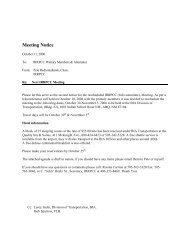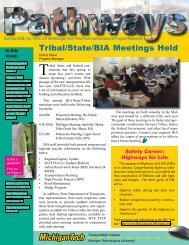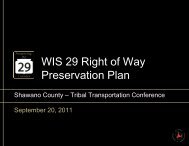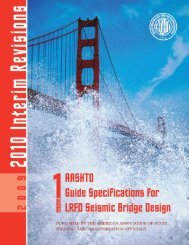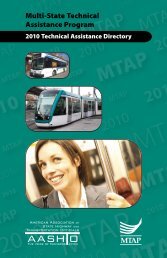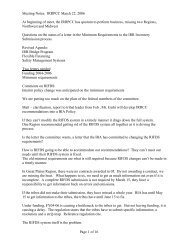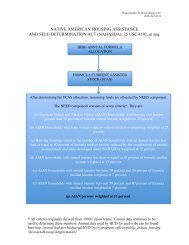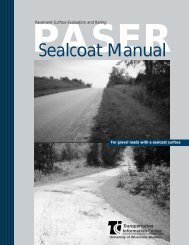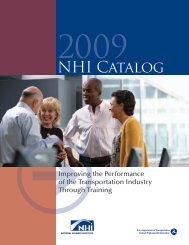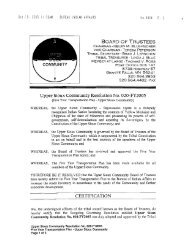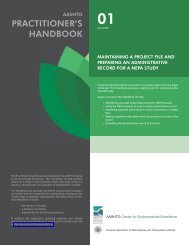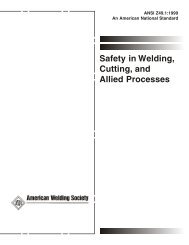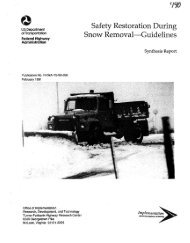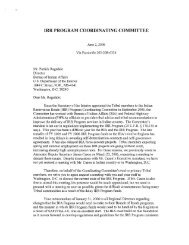Sac and Fox Tribe of the Mississippi in Iowa Long Range ...
Sac and Fox Tribe of the Mississippi in Iowa Long Range ...
Sac and Fox Tribe of the Mississippi in Iowa Long Range ...
Create successful ePaper yourself
Turn your PDF publications into a flip-book with our unique Google optimized e-Paper software.
Chapter 4<br />
Transportation Plan<br />
An effective transportation plan must convert <strong>in</strong>to an action program which schedules<br />
proposed improvements <strong>in</strong> accordance with available funds. Funds must be matched to<br />
<strong>the</strong> prioritized improvements when funds are not sufficient enough to provide for all <strong>the</strong><br />
current or future needs-. This will result <strong>in</strong> <strong>the</strong> development <strong>of</strong> a Transportation Program.<br />
As each year goes by, adjustments may need to be made <strong>in</strong> <strong>the</strong> programm<strong>in</strong>g to fit<br />
changes <strong>in</strong> fund<strong>in</strong>g, policies, l<strong>and</strong> use, public dem<strong>and</strong>s, etc.<br />
The <strong>Tribe</strong> can request a change to <strong>the</strong> BIA Road System to create or delete mileage, to<br />
transfer mileage or to change <strong>the</strong> class <strong>of</strong> <strong>the</strong> road. Roads can have <strong>the</strong>ir right-<strong>of</strong>-way<br />
transferred to <strong>the</strong> BIA road system if <strong>the</strong> road was designed <strong>and</strong> built to American<br />
Association <strong>of</strong> State Highway <strong>and</strong> Transportation Officials (AASHTO) st<strong>and</strong>ards,<br />
<strong>in</strong>spected by a qualified <strong>in</strong>spector, accepted by <strong>the</strong> BIA <strong>and</strong> accompanied with a<br />
ma<strong>in</strong>tenance agreement. Fur<strong>the</strong>rmore, <strong>the</strong> tribal council must pass a resolution<br />
request<strong>in</strong>g to modify <strong>the</strong> BIA road system.<br />
Roads are usually classified accord<strong>in</strong>g to <strong>the</strong>ir locale <strong>and</strong> usage. St<strong>and</strong>ards are<br />
established for <strong>the</strong> purpose <strong>of</strong> def<strong>in</strong><strong>in</strong>g m<strong>in</strong>imum criteria for <strong>the</strong> ma<strong>in</strong>tenance <strong>and</strong><br />
construction <strong>of</strong> rural <strong>and</strong> urban routes for each functional classification. These st<strong>and</strong>ards<br />
are used as a management tool <strong>and</strong> serve as guidel<strong>in</strong>es for decision mak<strong>in</strong>g. When<br />
comb<strong>in</strong>ed with <strong>in</strong>ventories conducted by <strong>the</strong> operators, <strong>the</strong>se guidel<strong>in</strong>es provide <strong>in</strong>sight<br />
<strong>in</strong>to network deficiencies.<br />
The follow<strong>in</strong>g sections identify <strong>and</strong> discuss <strong>the</strong> different st<strong>and</strong>ards that should be<br />
established for comparison purposes <strong>in</strong> order to allow <strong>the</strong> system operators to accurately<br />
determ<strong>in</strong>e exist<strong>in</strong>g <strong>and</strong> future network needs.<br />
Ma<strong>in</strong>tenance<br />
Road ma<strong>in</strong>tenance is a key adm<strong>in</strong>istrative <strong>and</strong> operational activity that plays an important<br />
role <strong>in</strong> <strong>the</strong> implementation <strong>of</strong> a transportation plan. An appropriately adm<strong>in</strong>istered<br />
ma<strong>in</strong>tenance program is a crucial factor <strong>in</strong> achiev<strong>in</strong>g maximum efficiency from a<br />
transportation network. Proper ma<strong>in</strong>tenance can also reduce <strong>the</strong> need for major<br />
refurbishment efforts <strong>in</strong> <strong>the</strong> future.<br />
An evaluation <strong>of</strong> ma<strong>in</strong>tenance needs for <strong>the</strong> basic IRR system was conducted as part <strong>of</strong><br />
this study. The purpose <strong>of</strong> this evaluation was to assess <strong>the</strong> amount <strong>of</strong> effort <strong>and</strong> funds<br />
necessary <strong>in</strong> order to ma<strong>in</strong>ta<strong>in</strong> <strong>the</strong> network. The dollar value <strong>of</strong> ma<strong>in</strong>tenance on <strong>the</strong>se<br />
routes is shown <strong>in</strong> Table 4-3. Annual ma<strong>in</strong>tenance amounts were calculated for a 0.10<br />
mile section <strong>of</strong> road based on surface type (paved, granular or ear<strong>the</strong>n). It was assumed<br />
that a paved road would have jo<strong>in</strong>ts <strong>and</strong> cracks sealed every five years <strong>and</strong> <strong>the</strong> shoulders<br />
reworked every three years. The related cost for annual upkeep for a 0.10 section <strong>of</strong><br />
paved roads is $750. For a granular road, <strong>the</strong> surface should be regraded <strong>and</strong> rerocked<br />
twice annually which leads to annual ma<strong>in</strong>tenance costs <strong>of</strong> $2500 per 0.10 mile section.<br />
There are m<strong>in</strong>imal costs associated with <strong>the</strong> annual upkeep <strong>of</strong> ear<strong>the</strong>n roads. These see



